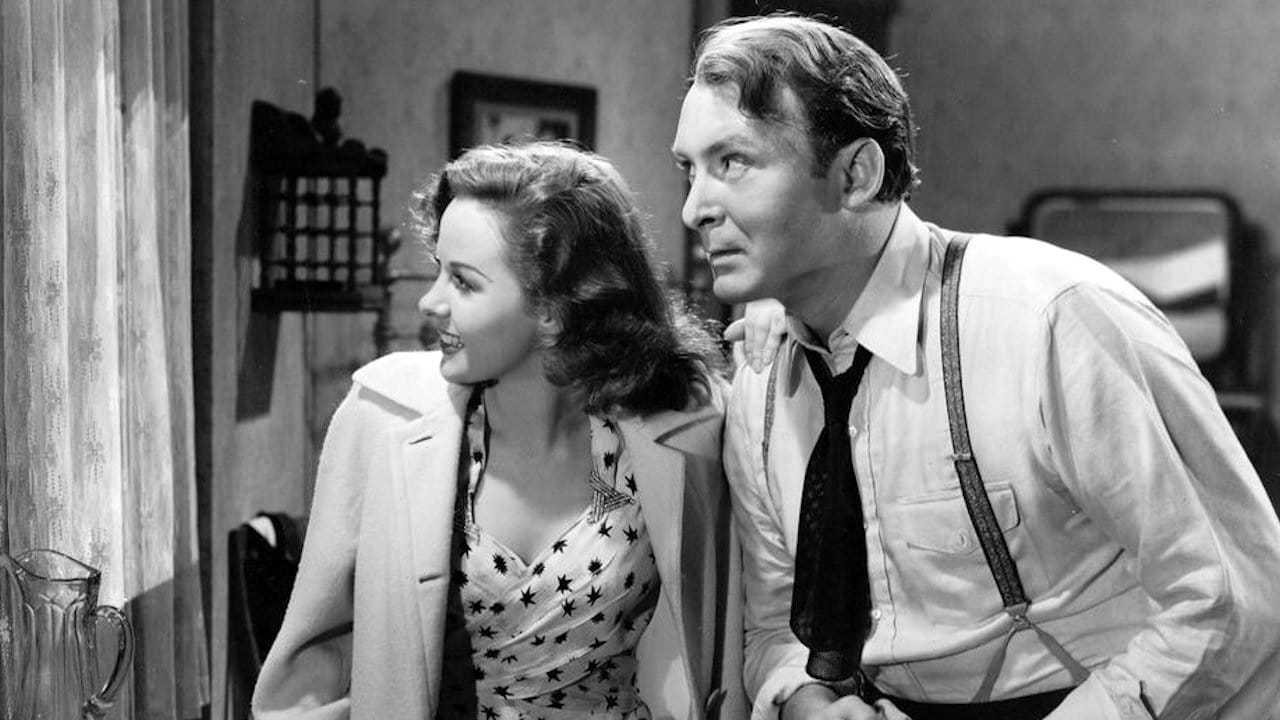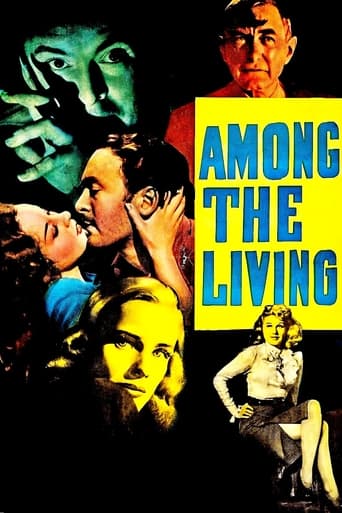

Among the Living opens on a funeral. The patriarch to a wealthy family has died, and the man's son, Albert Dekker, returns home to pay his respects after twenty-five years away. Harry Carey, the family doctor, and Ernest Whitman, the family servant, are glad to see him but wary of his return to town. Twenty-five years ago, Albert's twin brother died, and ever since, Harry and Ernest have been keeping a terrible secret from the family and the town. . .There's a lot more to the plot, and if you look this movie up on IMDb, you'll read much more than I'm telling you. However, I think it's more exciting sometimes to watch a movie without knowing too much about it. There are lots of surprises in this thriller, and it's great to watch around Halloween. Yes, it's a little dated, and Susan Hayward's acting is atrocious, but if you like the campy black-and-white scary flicks from the olden days, turn off all the lights and huddle close to your popcorn!
... View MoreWhere does insanity start? It truly varies from patient to patient, but in many cases, it's obviously child abuse, and that is the theme here as one of two twin brothers ends up in a straight jacket in the family mansion's attic because of abuse he went through at the hands of his evil father. Years later, the old man has died, and now he's out on the street where havoc, death and destruction are sure to follow. Albert Dekker, who the year before played the equally menacing Dr. Cyclops, plays two sides of the coin; The sane brother who managed to escape his father's wrath and the brain damaged twin who only ended up in a straight jacket because he defended his mother against an equally brutal attack by his father. Moving into a boarding house run by spunky Maude Eburne, he fells in love with her daughter (a young Susan Hayward) but after a visit with his brother (whom he viciously attacks in front of sister-in-law Frances Farmer) goes on a rampage, stalking and brutally killing a young blonde he saw in a tavern. The insane brother shows gentility and total sanity when he's with Hayward, but that's most likely going to snap at any moment, especially when Hayward decides she's going to find the mysterious killer on the loose and asks him for his help. Harry Carey is excellent as the family doctor who knows the truth about the troubled family's past and tries to help the insane brother to no avail. Hayward is her typical tough cookie, claiming "For $5000, I'm not afraid of anything, including death", but unfortunately, Farmer (who around this time was dealing with serious mental issues herself) is totally wasted. Her small role does give the indication, however, how great she would have been in the same types of roles which were given to newcomers such as Veronica Lake, Lauren Bacall and Lizabeth Scott with her husky voice and seemingly tough demeanor. The tension builds up as does the pressure with Dekker in getting caught in his own trap, and this makes for a very exciting conclusion. An early example of film noir which mixes in elements of horror, Dekker's insane brother could be described as a live version of Frankenstein's monster as his gentility and madness are mixed to provide him with a very hair-raising performance. This is a forgotten sleeper which very much deserves to be re-discovered.
... View MoreAlthough Among The Living is a B film from Paramount it's a real nugget of gold among a lot of B dross. You will rarely see mob violence depicted as well as in this film. Two films that this stands comparison with in that regard are Fury and Night Of The Hunter.It's also a great example of the mobility of careers. Frances Farmer whose career was heading down is in a relatively colorless part of the wife of one Albert Dekker. Susan Hayward plays the slutty daughter of a boardinghouse owner who gets involved with the other twin Dekker. She's got the far juicier role and makes the most of it.Once upon a time a man had two twin sons both of whom grew up to be Albert Dekker. As is told by the town doctor Harry Carey, one was sent to a prep school, the other stayed at home. By all accounts dad was a tyrant at home and at work where he owned the mill that employed most of the town. The twin that stayed at home witnessed dad beating on mom and tried to stop it. Dad picked him and threw him against a wall injuring his brain. Rather than risk exposure dad had his friend Harry Carey fake a death certificate and they kept the kid in a locked room. Now father is dead and the kid who has grown up to be Albert Dekker is a now quite unhinged and murders a family servant to escape.And while out murders a woman that the town blames his brother for. Quite a dilemma for the sane Dekker and wife Farmer.Hayward gives a good account of herself, but the film really belongs to Albert Dekker. This is quite possibly his career film, even more so than Dr. Cyclops. Especially playing the mad son, you really do feel for him knowing it's not his fault the way he is.With a good does of both noir and Gothic horror, I highly recommend this film for fans of both genres. And definitely for fans of Susan Hayward as I am.
... View MoreA more or less routine programmer enlivened by a sparky performance from a cute, young, flirtatious, materialistic, and cheerfully candid Susan Hayward.Albert Dekker plays twins, the sons of a wealthy mill owner in a Southern town. The story has their identities getting mixed up, madness, a murder, the wrong twin blamed, and so forth. Such mix ups aren't rare in the theater or movies. Except for the fact that it's a dramatic thriller, it might have inspired by Shakespeare's first play, "The Comedy of Errors", or from Plautus, from whom Old Bill ripped it off in the first place. But in fact the origins of the idea of mixed identities and twins is probably lost in the mists of the Mousterian Age.Where was I? Oh, yes. Okay. So we have this double Dekker, a Zweidekker, if you like. John Raden -- that's the SANE Dekker -- has been sent off to school at about the same time the other Dekker, Paul, has begun to show signs of what passes for insanity in this B feature. His eyes are open wide and he wears an idiotic smile. He speaks in a high voice and is ingenuous in the way an innocent child is. He's without art or guile. Except when he hears women scream. Then he turns into a raving maniac and has an unfortunate tendency to strangle people during a vesuvian outburst.He strangles his old African-American guardian, Pompeii, who has been taking care of him in the old, wrecked family mansion. That's the mad Dekker I'm referring to. He's been kept secretly in a locked room upstairs, sometimes wearing a straight jacket. The friendly old town doctor, Harry Carey, signed a false death certificate for Paul in an attempt to save the wealthy family any embarrassment. So the whole town mistakenly thinks Paul is dead, just as the world of pop music would think in 1968.John returns to the town, intending to re-open the mill, which had closed during the depression. Frances Farmer, who looks striking, has practically nothing to do as his wife. Sane John and beautiful Frances put up in a hotel rather than return to the dilapidated mansion which folks now believe to be haunted. We don't see much of them for the remainder of the film.The story follows the goggle-eyed Paul. After strangling Pompeii and stealing a horde of cash, he wanders the streets of the town, which is all new to him because he's been locked up for two decades. And it's certain he's never been allowed to look at anyone as sexy and forthcoming as Susan Hayward, the daughter of the boarding house keeper where Paul rents a room. Her character is chipper and she brings some life into what is otherwise a rather somber and not very interesting narrative. I might observe that it's a little odd to hear these Southerners -- Hayward, Dekker, and Harry Carey -- in conversations. Two are from Brooklyn and one from the Bronx.I don't think I'll gave away the end, though I guess we can mention that it involves a frenzied pursuit of the innocent Dekker by a lynch mob. There are multiple implausibilities towards the end and one big hole. John can't prove that he's not Paul. Nobody believes him, since they think Paul is dead, right? But Frances Farmer, John's wife, is right there, looking fretful but standing silently among the mob members. She could save his bacon with a few words, but then we wouldn't have the villagers with their torches and pitchforks shouting and hooting as they chase the innocent Dekker through the studio woods.
... View More